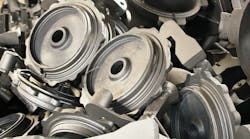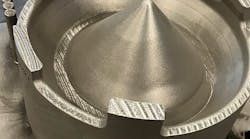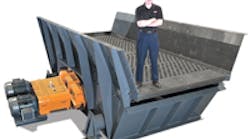In 1991, there were 3,200 metalcasting plants in the United States, and imports were cutting into domestic foundries' market share. Now, there are approximately 2,200 plants in operation. Today, even though Chinese foundries produce twice as much tonnage, they operate 10 times as many facilities. Still, forecasts call for increases in domestic production and a reduced rate of import growth.
Domestic foundries have adapted by adopting leaner manufacturing methods, and better technology has been the key to this remarkable advantage in efficiency. Carrier’s Delta Phase® is an example of progress in metalcasting technology driven by the need to increase throughput and efficiency. Progressive foundries have discarded inefficient shakeouts in favor of new technology that allows them to produce more high-quality castings with less equipment, fewer people, and reduced maintenance.
Carrier’s patented Delta Phase shakeout improves efficiency by lowering maintenance costs, reducing or eliminating casting damage, and maximizing sand removal. Perhaps an even greater advantage is that a single Delta Phase shakeout can handle a wide range of molding processes, mold sizes, metal types, and casting designs by adjusting to ever-changing production demands.
Quantifiable returns — The Delta Phase was designed for maintenance and process flexibility. Metalcasters are sensitive to the time and costs associated with the maintenance of their equipment. By reducing maintenance and increasing operational flexibility, the Delta Phase will pay immediate dividends.
It can be used for sand to metal ratios as low as 5:1 and as high as 60:1. The provided controls accommodate an unlimited number of recipes for diverse casting production. In addition to main line sand/casting separation, the shakeout may also be used for lump breakers, sprue cleaning, and casting de-accumulation.
No overstroke — The key feature of the Delta Phase Shakeout is directdrive technology. Direct drive is a simple, robust design that uses long-life, spherical roller bearings and eccentric weights to drive the system. The eccentric weights are inertially synchronized, which eliminates the need for any gearboxes or timing belts.
Compare this design to a two-mass natural-frequency shakeout, with its multiple vibrating masses and a forest of coil springs, and the advantages are obvious. Although the naturalfrequency design is precisely tuned to reduce the horsepower requirements of the shakeout, it is also very sensitive to any upset conditions or lax preventative maintenance. Most owners of natural-frequency shakeouts are well aware of the problems that usually occur after a period of tough operation: sticking sand, jammed castings, and loose springs. The typical result is hours of downtime to repair cracks or replace springs.
Overstroke is the leading cause of structural damage in all vibratory equipment. The directdrive design is not a tuned natural-frequency system, therefore it is not sensitive to mass and speed changes or loose springs, all of which cause an overstroke condition. The Delta Phase shakeout will not overstroke due to its directdrive design.
Process control — The heart of the patented Delta Phase shakeout is the process controller. Using simple and reliable electronics, the Delta Phase shakeout is able to precisely control the angle of vibration and operating frequency. Changing the vibration angle controls the conveying speed and retention time of castings on the shakeout deck, optimizing sand removal. The operator can accurately and automatically change the angle and frequency, even on the fly.
Most foundries produce a wide variety of casting shapes and sizes, which can be readily accommodated by using preprogrammed settings. Each casting type can be assigned a set of pre-determined shakeout parameters to optimize sand removal without damaging the casting. Using common VFD and PLC technology, the angle of vibration and/or operating frequency is changed to meet each unique shakeout requirement. When a fragile casting is processed, the angle of vibration and/or frequency may be lowered in order to reduce the retention time and the overall force imparted onto the casting. When a heavy casting is processed, the angle is increased to increase retention time and improve sand removal.
The Delta Phase is typically operated in “stop-and-go” mode or “continuous” mode. In “stop-and-go” mode, the angle of vibration is set at vertical once the mold reaches the center of the shakeout. Separation of sand from the casting and lump breakdown continues until the next mold approaches the shakeout. In continuous mode, the angle of vibration is set and maintained to provide the optimum retention time for the castings being produced. When a new casting is made, the angle of vibration is changed to its optimum angle.










